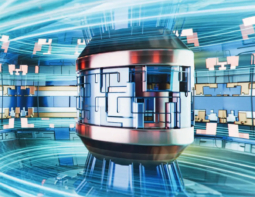Ever since the famous double-helix structure of DNA was discovered more than 50 years ago, researchers have struggled to understand the complex relationships between its structural, chemical and electrical properties. One mystery has been why attempts to measure the electrical conductivity of DNA have yielded conflicting results suggesting that the molecule is an insulator, semiconductor, metal—and even a superconductor at very low temperatures
DNA’s apparent metallic and semiconductor properties along with its ability to self-replicate has led some researchers to suggest that it could be used to create electronic circuits that assemble themselves. Now, however a team of researchers in the US has shown that DNA’s electrical conductivity is extremely sensitive to tiny structural changes in the molecule — which means that it could be very difficult to make reliable DNA circuits.
Reliable connection
Colin Nuckolls of Columbia University, Jacqueline Barton of Caltech and colleagues were able to make reliable conductivity measurements by inventing a new and consistent way of connecting a single DNA molecule to two carbon nanotubes (Nature Nanotechnology 3 163). Past methods had struggled to make a reliable connection between a DNA molecule — which is only about 2 nm wide— and two electrodes. Poor connectivity is thought to be behind many of the inconsistencies in previous measurements.
The team began with a nanotube — a tiny tube of carbon about as thick as DNA itself – that was integrated within a simple electrical circuit. A 6-nm section of the nanotube was removed using plasma ion etching. This procedure not only cuts the tube, but also oxidizes the remaining tips. This makes it possible to bridge the gap with a DNA molecule with ends that have been designed to form strong chemical bonds with the oxidized tips.
Similar to graphite
The conductivity was determined by simply applying 50 mV across the DNA and measuring the current that flowed through it. In a standard piece of DNA, the conductivity was similar to that seen in graphite. This is consistent with the fact that the core of the double helix of DNA consists of stacked molecular rings that have a similar structure to graphite.
A benefit of having the DNA attached securely to the electrodes is that the conductivity can be studied under ambient conditions — in a liquid at room temperature. This allowed the team to confirm that they were actually measuring the conductivity of DNA and not something else in the experiment. This was done by adding an enzyme to the surrounding liquid that cuts DNA – and as expected the electrical circuit was broken.
Mismatched bases
The team were also able to investigate the effect of base mismatches on conductivity. DNA double strands are normally connected through interactions between particular bases—adenine to thymine and cytosine to guanine. If one of the bases in a pair is changed, the two strands will still stick together, but with an altered structure around the mismatched bases.
The team first measured the conductivity of a well matched strand and then exchanged it for a strand with a single mismatch. This single mismatch boosted the resistance of the DNA by a factor of 300. According to Jacqueline Barton “this highlights the need to make measurements on duplex DNA that is well-matched, undamaged, and in its native conformation.”
An important implication of this sensitivity to small changes in structure is that DNA by itself might not be an ideal component for future electronic devices.
Indeed, this inherent sensitivity to structural change could allow living cells to detect DNA damage, which can accumulate in cells and lead to problems including cancer. Cells have ways of repairing this damage, but the mechanism they use to detect damage is still not completely understood. Barton says that this “whole body of experiments now begs the question of whether the cell utilizes this chemistry to detect DNA damage.” This is a question her group is now trying to answer.



